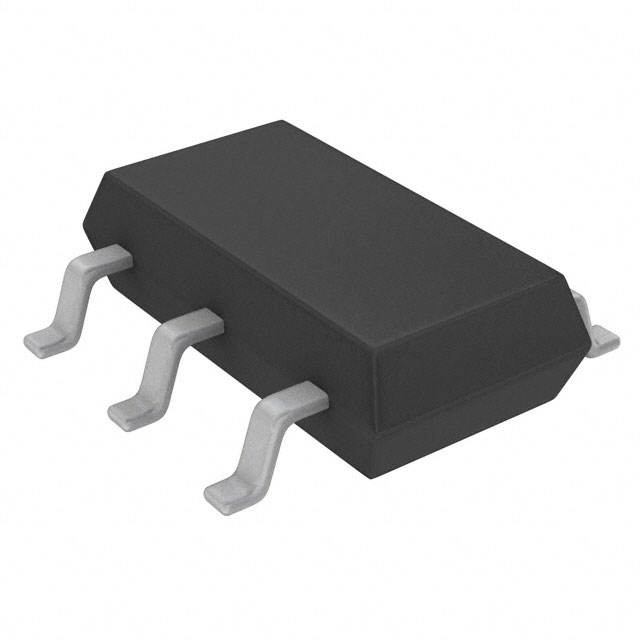LT6656BIS6-1.25#TRPBF
Product Overview
Category
The LT6656BIS6-1.25#TRPBF belongs to the category of precision voltage references.
Use
This product is primarily used in applications that require a stable and accurate voltage reference. It provides a precise voltage output that can be used as a reference for various electronic circuits.
Characteristics
- High accuracy: The LT6656BIS6-1.25#TRPBF offers exceptional accuracy with low temperature drift, ensuring reliable performance over a wide range of operating conditions.
- Low noise: It features low output noise, making it suitable for sensitive applications that require minimal interference.
- Low power consumption: This voltage reference operates with low power consumption, making it energy-efficient.
- Wide temperature range: The LT6656BIS6-1.25#TRPBF is designed to operate reliably across a wide temperature range, making it suitable for both industrial and consumer electronics applications.
Package
The LT6656BIS6-1.25#TRPBF is available in a small SOT-23 package, which is compact and easy to integrate into various circuit designs.
Essence
The essence of the LT6656BIS6-1.25#TRPBF lies in its ability to provide a stable and accurate voltage reference, ensuring precise operation of electronic circuits.
Packaging/Quantity
This product is typically supplied in tape and reel packaging, with a quantity of 3000 units per reel.
Specifications
- Output Voltage: 1.25V
- Initial Accuracy: ±0.05%
- Temperature Coefficient: 10ppm/°C
- Output Noise: 4μVrms (0.1Hz to 10Hz)
- Supply Voltage Range: 2.7V to 18V
- Quiescent Current: 1.5mA
Detailed Pin Configuration
The LT6656BIS6-1.25#TRPBF has a six-pin SOT-23 package with the following pin configuration:
- GND (Ground)
- VOUT (Output Voltage)
- NC (No Connection)
- NC (No Connection)
- NC (No Connection)
- VIN (Input Voltage)
Functional Features
- High precision voltage reference
- Low temperature drift for accurate performance over a wide range of temperatures
- Low output noise for minimal interference in sensitive applications
- Wide supply voltage range for versatile compatibility
- Compact package for easy integration into circuit designs
Advantages and Disadvantages
Advantages
- High accuracy and stability
- Low noise output
- Wide operating temperature range
- Energy-efficient operation
- Compact package size
Disadvantages
- Limited output voltage options
- Higher cost compared to standard voltage references
Working Principles
The LT6656BIS6-1.25#TRPBF is based on a bandgap voltage reference circuit. It utilizes a combination of temperature-compensated components to generate a stable reference voltage. The output voltage is highly accurate and remains relatively constant over a wide range of operating conditions.
Detailed Application Field Plans
The LT6656BIS6-1.25#TRPBF finds applications in various fields, including:
- Precision measurement equipment
- Industrial control systems
- Data acquisition systems
- Medical devices
- Automotive electronics
- Portable electronic devices
In these applications, the LT6656BIS6-1.25#TRPBF provides a reliable and precise voltage reference, ensuring accurate operation of the associated circuits.
Detailed and Complete Alternative Models
- LT6656AIS6-1.25#TRPBF: Similar to LT6656BIS6-1.25#TRPBF, but with a different pin configuration.
- LT6656CIS6-1.25#TRPBF: Offers the same voltage reference accuracy but with a different package type (SOT-23-6).
These alternative models provide similar functionality and can be considered as substitutes for the LT6656BIS6-1.25#TRPBF in specific applications.
Word count: 515 words
Senaraikan 10 soalan dan jawapan biasa yang berkaitan dengan aplikasi LT6656BIS6-1.25#TRPBF dalam penyelesaian teknikal
Sure! Here are 10 common questions and answers related to the application of LT6656BIS6-1.25#TRPBF in technical solutions:
Q1: What is the LT6656BIS6-1.25#TRPBF? A1: The LT6656BIS6-1.25#TRPBF is a precision voltage reference IC manufactured by Linear Technology (now part of Analog Devices). It provides a stable and accurate voltage reference of 1.25V.
Q2: What is the typical application of LT6656BIS6-1.25#TRPBF? A2: The LT6656BIS6-1.25#TRPBF is commonly used as a voltage reference in various electronic systems, such as analog-to-digital converters (ADCs), digital-to-analog converters (DACs), power supplies, and sensor interfaces.
Q3: What is the voltage accuracy of LT6656BIS6-1.25#TRPBF? A3: The LT6656BIS6-1.25#TRPBF has a voltage accuracy of ±0.05% at room temperature. This means that the output voltage will be within 1.25V ± 0.000625V.
Q4: What is the temperature coefficient of LT6656BIS6-1.25#TRPBF? A4: The temperature coefficient of the LT6656BIS6-1.25#TRPBF is typically 5ppm/°C. This means that for every degree Celsius change in temperature, the output voltage will change by approximately 5 parts per million (ppm).
Q5: What is the output current capability of LT6656BIS6-1.25#TRPBF? A5: The LT6656BIS6-1.25#TRPBF can provide up to 10mA of output current. It is important to ensure that the load does not exceed this limit to maintain voltage accuracy.
Q6: What is the input voltage range for LT6656BIS6-1.25#TRPBF? A6: The input voltage range for the LT6656BIS6-1.25#TRPBF is typically between 2.7V and 5.5V. Operating the device outside this range may result in inaccurate or unstable output voltage.
Q7: Does LT6656BIS6-1.25#TRPBF require an external capacitor? A7: Yes, the LT6656BIS6-1.25#TRPBF requires an external bypass capacitor connected between the REF pin and GND. This capacitor helps stabilize the output voltage and reduce noise.
Q8: Can LT6656BIS6-1.25#TRPBF operate in low-power applications? A8: Yes, the LT6656BIS6-1.25#TRPBF has a low quiescent current of typically 1.5mA, making it suitable for low-power applications where power consumption is a concern.
Q9: Is LT6656BIS6-1.25#TRPBF available in other voltage options? A9: Yes, Linear Technology offers the LT6656 series in various voltage options, including 1.2V, 2.048V, 2.5V, 3V, 4.096V, and 5V. These options allow designers to choose the appropriate voltage reference for their specific application.
Q10: Is LT6656BIS6-1.25#TRPBF RoHS compliant? A10: Yes, the LT6656BIS6-1.25#TRPBF is RoHS (Restriction of Hazardous Substances) compliant, ensuring that it meets the environmental standards set by the European Union.
Please note that the answers provided here are general and may vary depending on the specific datasheet and application requirements. It is always recommended to refer to the official documentation and consult with the manufacturer for accurate and up-to-date information.


